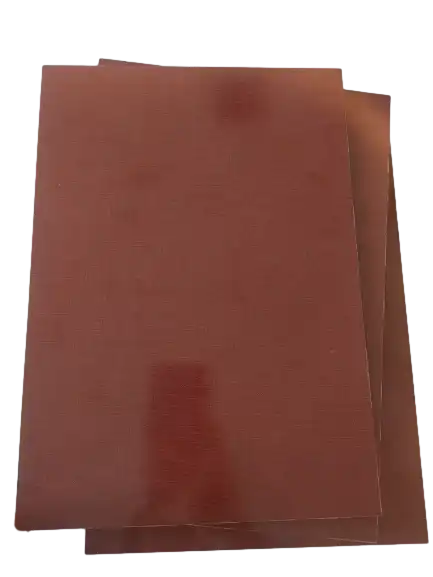Understanding CE Phenolic Sheet and Bakelite
Composition and Manufacturing Process
CE phenolic sheet is a composite material made from cotton fabric or paper impregnated with phenolic resin. The manufacturing process involves layering these impregnated sheets and subjecting them to high pressure and heat. This results in a dense, homogeneous material with excellent insulating properties. The "CE" in CE phenolic sheet stands for "Continuous Energy," referring to its ability to maintain its electrical and mechanical properties under continuous stress.
Bakelite, on the other hand, is one of the earliest synthetic plastics. It's created by combining phenol and formaldehyde under heat and pressure. While Bakelite was groundbreaking when it was first introduced, its manufacturing process has limitations compared to modern CE phenolic sheet production techniques.
Physical Properties and Characteristics
CE phenolic sheet boasts superior physical properties compared to Bakelite. It offers higher tensile strength, improved impact resistance, and better dimensional stability. These characteristics make CE phenolic sheet more suitable for applications requiring durability and precision. Additionally, CE phenolic sheet has a lower density than Bakelite, making it a lighter option for weight-sensitive applications.
Bakelite, while still a useful material, tends to be more brittle and less resistant to impact. It also has a higher thermal expansion coefficient, which can be problematic in applications with significant temperature fluctuations.
Electrical Insulation Capabilities
When it comes to electrical insulation, CE phenolic sheet outperforms Bakelite in several key areas. It offers higher dielectric strength, meaning it can withstand stronger electric fields without breaking down. CE phenolic sheet also maintains its insulating properties over a wider temperature range, making it more versatile for various electrical applications.
Bakelite, while a good insulator, doesn't match the performance of CE phenolic sheet in extreme conditions. Its insulating properties can degrade more quickly when exposed to high temperatures or humidity, limiting its use in certain environments.
Applications and Industry Usage
Electrical and Electronics Industry
In the electrical and electronics industry, CE phenolic sheet is widely used for its exceptional insulating properties. It's commonly found in switchgear, circuit breakers, and transformer components. The material's ability to maintain its electrical characteristics under high stress and temperature makes it invaluable in these applications.
CE phenolic sheet is also utilized in printed circuit board (PCB) manufacturing, particularly for high-performance applications. Its low water absorption and excellent dimensional stability ensure consistent performance in varying environmental conditions.
Mechanical and Industrial Applications
Beyond electrical applications, CE phenolic sheet finds extensive use in mechanical and industrial settings. Its high compressive strength and wear resistance make it ideal for bearings, gears, and other components subject to mechanical stress. In the automotive industry, CE phenolic sheet is used for various under-the-hood components due to its heat resistance and durability.
The material's chemical resistance also makes it suitable for use in harsh industrial environments. It's often employed in chemical processing equipment, pump components, and seals where exposure to corrosive substances is a concern.
Aerospace and Defense Sectors
The aerospace and defense sectors have embraced CE phenolic sheet for its unique combination of properties. Its light weight, high strength-to-weight ratio, and excellent insulating capabilities make it perfect for aircraft interiors, structural components, and radar systems.
In defense applications, CE phenolic sheet is used in military vehicles, communication equipment, and even ballistic protection systems. Its ability to maintain performance under extreme conditions is particularly valued in these high-stakes environments.
Performance Comparison and Selection Criteria
Thermal Properties and Heat Resistance
When it comes to thermal properties, CE phenolic sheet demonstrates superior performance compared to Bakelite. It maintains its structural integrity and insulating properties at higher temperatures, typically up to 150°C for continuous use, with some grades capable of withstanding even higher temperatures for short periods. This heat resistance makes CE phenolic sheet ideal for applications in high-temperature environments, such as in automotive or industrial machinery.
Bakelite, while heat-resistant to some degree, tends to soften and lose its insulating properties at lower temperatures compared to CE phenolic sheet. This limitation can restrict its use in applications where consistent performance under heat is crucial.
Chemical Resistance and Environmental Durability
CE phenolic sheet exhibits excellent chemical resistance, making it suitable for use in environments where exposure to acids, alkalis, or other corrosive substances is a concern. It's particularly resistant to oils, fuels, and many common solvents, which broadens its applicability in various industrial settings.
While Bakelite offers some chemical resistance, it's generally not as robust as CE phenolic sheet in this regard. Prolonged exposure to certain chemicals can cause Bakelite to degrade more quickly, potentially compromising its structural and insulating properties.
Cost-Effectiveness and Long-Term Value
When considering cost-effectiveness, it's essential to look beyond the initial purchase price. While CE phenolic sheet may have a higher upfront cost compared to Bakelite, its superior durability and performance characteristics often result in better long-term value. The extended lifespan and reduced need for replacement or maintenance can lead to significant cost savings over time.
Moreover, the versatility of CE phenolic sheet allows for its use in a wider range of applications, potentially reducing the need for multiple materials and simplifying inventory management. This versatility, combined with its excellent performance, makes CE phenolic sheet a cost-effective choice for many industries.
Conclusion
In the comparison between CE phenolic sheet and Bakelite, CE phenolic sheet emerges as the superior choice for most modern applications. Its advanced formulation offers enhanced electrical insulation, improved mechanical properties, and better resistance to heat and chemicals. While Bakelite has its place in certain niche applications, CE phenolic sheet's versatility and performance make it the preferred option across various industries. When selecting insulating materials, consider the specific requirements of your application, but keep in mind the numerous advantages that CE phenolic sheet brings to the table. Its ability to deliver consistent performance in demanding environments makes it a reliable and future-proof choice for your insulation needs.
Contact Us
Ready to explore how CE phenolic sheet can benefit your specific application? Our team of experts is here to help. With over 20 years of experience in producing and selling insulating sheets, we can provide tailored solutions to meet your unique requirements. Contact us today at info@jhd-material.com to learn more about our high-quality CE phenolic sheets and how they can enhance your projects.






